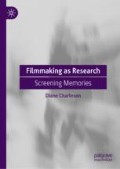Abstract
In order to be fully successful and sustainable, researchers need to address areas such as ontology and epistemology. With such an understanding, practitioners will ensure that the filmmaking practice is academically rigorous and has full integrity. They need to look inwardly in order to be able to articulate the tacit. What and why are they interested in what they are researching? In order to answer these questions, I examined my own research. As a result of this examination, I have defined five main areas of interest for me that are pivotal to my work. Central to these is the agency of the importance of family stories and photographs and the impact these have had on me as a filmmaker. This interest is inextricably linked with notions of memory and remembering and how these processes have been represented visually. Importantly for my practice has been a fascination with Super 8 film as a medium, in particular in the form of found home movies that I use extensively in my practice. In this chapter, I contextualize these themes which are at the heart of my research and which permeate the book.
Access this chapter
Tax calculation will be finalised at checkout
Purchases are for personal use only
Bibliography
Alea, N., and S. Bluck. “I’ll Keep You in Mind: The Intimacy Function of Autobiographical Memory.” Applied Cognitive Psychology 21, no. 8 (2007): 1091–1111.
Barthes, R. Camera Lucida: Reflections on Photography. London: Vintage, 2000.
Bluck, Susan, Nicole Alea, Tilmann Habermas, and David Rubin. “A Tale of Three Functions: The Self-Reported Uses of Autobiographical Memory.” Social Cognition 23, no. 1 (2005): 91–117.
Cambridge Super 8 Film Festival, “Flicker: Artists and Super 8”. UK, 2015. Available at http://www.cambridge-super8.org/archives/flicker-artists-super-8/. Accessed August 10, 2015.
Charleson, D. “Modern Icons: Aura and Memory in Super 8 Still Frames.” Visual Resources 32, no. 1–2 (2016): 169–188.
Chasiotis, Athanasios, Michael Bender, Florian Kiessling, and Jan Hofer. “The Emergence of the Independent Self: Autobiographical Memory as a Mediator of False Belief Understanding and Sociocultural Motive Orientation in Cameroonian and German Preschoolers.” Journal of Cross-Cultural Psychology 41, no. 3 (2010): 368–390.
Cherry, P. Screen Language from Film Writing to Filmmaking. Great Britain: Methuen, 2001.
Conway, J. K. When Memory Speaks: Reflections on Autobiography. New York: Alfred A. Knopf, 1998.
Cox, Paul. Man of Flowers. Directed by C. Paul. Australia, 1983.
Crotty, M. The Foundations of Social Research: Meaning and Perspective in the Research Process. St Leonards, NSW: Allen & Unwin, 1998.
Elliott, A. Concepts of the Self. 3rd ed. Cambridge: Polity Press, 2014.
Fox, W. “Fred Davis”: Yearning for Yesterday (Book Review). Chapel Hill: University of North Carolina Press, 1981.
Gibson, R. Remembrance and the Moving Image. Melbourne, 2002. Available at https://2015.acmi.net.au/exhibitions/past-exhibitions/2003/remembrance-plus-the-moving-image/. Accessed November 12, 2018.
Gondry, M. Eternal Sunshine of the Spotless Mind. Glendale, CA: Dreamworks, 2004.
Haaken, J. Memory, Narrative, Identity: Remembering the Self. Abingdon: Taylor & Francis, 2001.
Habermas, Tilmann, and Christin Köber. “Autobiographical Reasoning in Life Narratives Buffers the Effect of Biographical Disruptions on the Sense of Self-Continuity.” Memory 23, no. 5 (2014): 1–1.
Ishizuka, K. L., and P. R. Zimmermann. Mining the Home Movie Excavations in Histories and Memories. Berkeley: University of California Press, 2008.
Kearney, Richard. On Stories. London and New York: Routledge, 2001.
Kerrigan, S. “A ‘Logical’ Explanation of Screen Production as Method-Led Research.” In Screen Production Research: Creative Practice as a Mode of Enquiry, edited by C. Batty and S. Kerrigan, 11–27. Cham: Springer International Publishing, 2018.
Kuhn, A. Family Secrets: Acts of Memory and Imagination. London and New York: Verso, 1995.
Meissner, W. Handbook of Experimental Existential Psychology. New York, 2007.
Middleton, David, and Steve D. Brown. The Social Psychology of Experience Studies in Remembering and Forgetting. London: Sage, 2005.
Nicholson, H. N. “Seeing How It Was? Childhood Geographies and Memories in Home Movies.” Area 33, no. 2 (2001): 128–140.
Nolan, C. Memento. Directed by N. Christopher. United States, 2001.
Pink, S. “Amateur Photographic Practice, Collective Representation and the Constitution of Place.” Visual Studies 26, no. 2 (2011): 92–101.
Resnais, A. Hiroshima Mon Amor. Directed by Alain Resnais. France, 1959.
Singer, Jefferson A., Pavel S. Blagov, Meredith Berry, and Kathryn Oost. “Self‐Defining Memories, Scripts, and the Life Story: Narrative Identity in Personality and Psychotherapy.” Journal of Personality 81, no. 6 (2013): 569–582.
Sontag, S. On Photography. London: Penguin, 2008.
Trigg, F. “Bourgeois Dictionaries/Meanwhile Somewhere.” Remembrance and the Moving Image, 2002.
Wildschut, Tim, Constantine Sedikides, Jamie Arndt, and Clay Routledge. “Nostalgia: Content, Triggers, Functions.” Journal of Personality and Social Psychology 91, no. 5 (2006): 975–993.
Author information
Authors and Affiliations
Corresponding author
Rights and permissions
Copyright information
© 2019 The Author(s)
About this chapter
Cite this chapter
Charleson, D. (2019). Thematic Concentrations: My Research World. In: Filmmaking as Research. Palgrave Macmillan, Cham. https://doi.org/10.1007/978-3-030-24635-8_3
Download citation
DOI: https://doi.org/10.1007/978-3-030-24635-8_3
Published:
Publisher Name: Palgrave Macmillan, Cham
Print ISBN: 978-3-030-24634-1
Online ISBN: 978-3-030-24635-8
eBook Packages: Literature, Cultural and Media StudiesLiterature, Cultural and Media Studies (R0)

